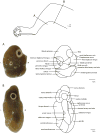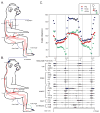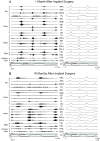Methods for chronic recording of EMG activity from large numbers of hindlimb muscles in awake rhesus macaques
- PMID: 20346976
- PMCID: PMC2878855
- DOI: 10.1016/j.jneumeth.2010.03.011
Methods for chronic recording of EMG activity from large numbers of hindlimb muscles in awake rhesus macaques
Abstract
Studies of the neural control of movement often rely on the ability to record EMG activity during natural behavioral tasks over long periods of time. Increasing the number of recorded muscles and the time over which recordings are made allows more rigorous answers to many questions related to the descending control of motor output. Chronic recording of EMG activity from multiple hindlimb muscles has been reported in the cat but few studies have been done in non-human primates. This paper describes two chronic EMG implant methods that are minimally invasive, relatively non-traumatic and capable of recording from large numbers of hindlimb muscles simultaneously for periods of many months to years.
Copyright (c) 2010 Elsevier B.V. All rights reserved.
Figures





Similar articles
-
Cortical Effects on Ipsilateral Hindlimb Muscles Revealed with Stimulus-Triggered Averaging of EMG Activity.Cereb Cortex. 2016 Jul;26(7):3036-51. doi: 10.1093/cercor/bhv122. Epub 2015 Jun 17. Cereb Cortex. 2016. PMID: 26088970 Free PMC article.
-
Chronic recording of EMG activity from large numbers of forelimb muscles in awake macaque monkeys.J Neurosci Methods. 2000 Mar 15;96(2):153-60. doi: 10.1016/s0165-0270(00)00155-2. J Neurosci Methods. 2000. PMID: 10720680
-
Electromyogram recordings from freely moving animals.Methods. 2003 Jun;30(2):127-41. doi: 10.1016/s1046-2023(03)00074-4. Methods. 2003. PMID: 12725779 Review.
-
Long-term decoding of movement force and direction with a wireless myoelectric implant.J Neural Eng. 2016 Feb;13(1):016002. doi: 10.1088/1741-2560/13/1/016002. Epub 2015 Dec 8. J Neural Eng. 2016. PMID: 26643959
-
Contributions to the understanding of gait control.Dan Med J. 2014 Apr;61(4):B4823. Dan Med J. 2014. PMID: 24814597 Review.
Cited by
-
Muscle synergies obtained from comprehensive mapping of the primary motor cortex forelimb representation using high-frequency, long-duration ICMS.J Neurophysiol. 2017 Jul 1;118(1):455-470. doi: 10.1152/jn.00784.2016. Epub 2017 Apr 26. J Neurophysiol. 2017. PMID: 28446586 Free PMC article.
-
Cortical Effects on Ipsilateral Hindlimb Muscles Revealed with Stimulus-Triggered Averaging of EMG Activity.Cereb Cortex. 2016 Jul;26(7):3036-51. doi: 10.1093/cercor/bhv122. Epub 2015 Jun 17. Cereb Cortex. 2016. PMID: 26088970 Free PMC article.
-
Properties of primary motor cortex output to hindlimb muscles in the macaque monkey.J Neurophysiol. 2015 Feb 1;113(3):937-49. doi: 10.1152/jn.00099.2014. Epub 2014 Nov 19. J Neurophysiol. 2015. PMID: 25411454 Free PMC article.
-
Muscle Synergies Obtained from Comprehensive Mapping of the Cortical Forelimb Representation Using Stimulus Triggered Averaging of EMG Activity.J Neurosci. 2018 Oct 10;38(41):8759-8771. doi: 10.1523/JNEUROSCI.2519-17.2018. Epub 2018 Aug 27. J Neurosci. 2018. PMID: 30150363 Free PMC article.
-
Cortical output to fast and slow muscles of the ankle in the rhesus macaque.Front Neural Circuits. 2013 Mar 1;7:33. doi: 10.3389/fncir.2013.00033. eCollection 2013. Front Neural Circuits. 2013. PMID: 23459919 Free PMC article.
References
-
- Belhaj-Saïf A, Fourment A, Maton B. Adaptation of the precentral cortical command to elbow muscle fatigue. Exp Brain Res. 1996;111:405–16. - PubMed
-
- Bretzner F, Drew T. Contribution of the motor cortex to the structure and the timing of hindlimb locomotion in the cat: a microstimulation study. J Neurophysiol. 2005;94:657–72. - PubMed
-
- Courtine G, Roy RR, Hodgson J, McKay H, Raven J, Zhong H, Yang H, Tuszynski MH, Edgerton VR. Kinematic and EMG determinants in quadrupedal locomotion of a non-human primate (Rhesus) J Neurophysiol. 2005;93:3127–45. - PubMed
-
- Drew T. Motor cortical cell discharge during voluntary gait modification. Brain Res. 1988;457:181–7. - PubMed
-
- Fetz EE, Cheney PD. Postspike facilitation of forelimb muscle activity by primate corticomotoneuronal cells. J Neurophysiol. 1980;44:751–72. - PubMed
Publication types
MeSH terms
Grants and funding
LinkOut - more resources
Full Text Sources
Miscellaneous

